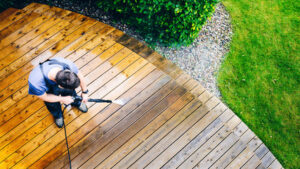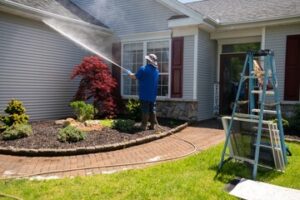Austin Pressure Washing is no longer just about blasting grime away. It has evolved into a multi-functional solution. Today’s systems are smarter, quieter, and more precise. The practice now blends science, design, and ecology.

Modern pressure washing tools are designed with silent nozzles. These reduce decibel levels by more than half. It allows residential cleaning without disturbing neighbors. The industry is focusing on low-impact sound.
A trend in thermal-assisted washing is also growing. Heated water combined with pressure increases efficiency. It melts away oils and sticky debris. This reduces detergent usage and time spent on each surface.
Data-driven cleaning paths are the latest innovation. Machines now track optimal spray movement. They adjust water intensity based on dirt density. Surfaces are cleaned thoroughly without overexposure to force.
AI-assisted pressure washers are being tested. Sensors detect the material type in real-time. The pressure adjusts before contact. It prevents surface damage and extends structure life.
Transparent water use logs are being introduced. Clients can now track how much water was used. This encourages conservation and accountability. It also helps estimate project costs more accurately.
Multi-layered cleaning is the new standard in delicate zones. A pre-spray soft rinse removes surface dust. Then a mild pressure wash follows. This reduces surface fatigue on older materials.
There is a new focus on microbial reduction. Pressure washing no longer stops at visible dirt. Systems use agents that neutralize spores and pathogens. This is crucial for outdoor areas with high foot traffic.
The inclusion of scent-neutral sprays is rising. These remove moldy smells without synthetic perfumes. The aim is freshness without chemical overtones. Homes smell cleaner, not covered up.
Surfaces are now being mapped using light sensors. Before washing, a device scans for cracks or soft spots. These areas receive reduced pressure. It’s a precision-first approach.
Dual-stream machines are gaining popularity. They spray water and air in synchronized pulses. This lifts debris gently without scraping paint or stone. They’re especially useful for heritage properties.
Color-sensitive zones are also being considered. Lighter paints absorb more moisture and heat. They’re cleaned at slightly lower pressure. This protects hue consistency and finish longevity.
People are now using pressure washing as preparation for solar installation. Dust and pollen are removed from roofs. This boosts solar panel efficiency after installation. Cleanliness directly enhances energy output.
More technicians are training in architectural sensitivity. They study how surfaces age over time. Cleaning is then adjusted based on weathering signs. It’s a proactive method for property preservation.
The demand for chemical-free cleaning has led to mineral-boosted water systems. Natural elements break down grime faster. These alternatives are safe for gardens and wildlife. They represent a shift toward green washing solutions.
Pressure washers with built-in water recycling units are emerging. They collect used water for non-potable reuse. This dramatically reduces water waste. It’s sustainability in motion.
Time-of-day washing has become a strategy. Cooler hours prevent streaking on glass and metal. The wash quality improves under low sun. This creates cleaner finishes with fewer adjustments.
Pressure washing is now part of pest control. It clears away webs, nests, and organic buildup. This removes shelter for insects. It’s a non-invasive deterrent method.
Paint-prep washing has evolved into a delicate art. It’s not about blasting off old layers anymore. The aim is to gently expose the bonding surface. This allows for longer-lasting paint application.
Ergonomics is shaping tool design. Wands now tilt based on arm movement. Pressure adjusts through grip tension. This allows operators to clean for longer without fatigue.
Pressure washing is moving into public art maintenance. Statues and murals are cleaned using micron-level mist. It lifts soot without altering pigment. The art remains untouched but refreshed.
Solar reflections are being studied before rooftop washing. The angle of sunlight affects water patterns. Cleaning plans now include solar path tracking. It ensures no surface is left shaded or streaked.
Digital pressure maps are guiding new operators. Screens display ideal hand speed and spray distance. Real-time feedback improves accuracy. This shortens training and boosts outcome quality.
Some systems now include biodegradable foam layers. Foam lifts dirt before rinsing begins. This reduces direct pressure time on fragile surfaces. It’s perfect for old wood and painted trim.
Homeowners are requesting scentless zones after washing. These are patios or gardens where odor must be neutral. Technicians use pH-balanced water only. It respects plant life and resident comfort.
Clients are now asking for pressure prints. These are designs washed into sidewalks or decks. Subtle motifs appear as negative space. Art and cleaning now go hand in hand.
High-altitude pressure washing is being automated. Drones with mini hoses now clean roofs and towers. This removes risk to human workers. Safety increases while coverage expands.
Moisture-aware washing has reduced incidents of streaking. Sensors check air humidity before washing starts. Spray settings change accordingly. This improves results across weather types.
Pressure washers are also now part of seasonal allergy control. Pollen and mold are major triggers. Regular cleaning reduces allergens on siding and decks. Breathing becomes easier after a wash.
Visual wash paths are being projected on surfaces. A light outline shows the operator where to aim. This ensures full coverage with no overlaps. Cleaning becomes both precise and time-efficient.
Pressure washing now aids in thermal inspections. Before infrared scans, walls are cleaned to reduce false readings. This ensures better data for insulation planning. Dirt no longer masks heat loss.
Touchless control panels are replacing manual dials. Hands-free settings reduce contamination and wear. They also prevent accidental changes mid-clean. Simplicity and hygiene meet in design.
Low-pulse washing is used for loose material like gravel paths. It stabilizes the area while removing debris. Gravel stays in place while dirt lifts. The surface looks refreshed but undisturbed.
Techs are studying water acoustics in washing. The sound of splashback changes based on dirt thickness. Some use this to guide cleaning zones. It’s a subtle but smart method.
Home exteriors are being scanned before and after. 3D scans highlight improvement zones. This gives clients a visual report of cleanliness. It’s cleaning with metrics, not just assumptions.
Light-reflective drying is helping detect missed spots. As water evaporates, surfaces change tone. Any dirt left behind stays darker. This guides final touch-ups with precision.
Pressure washing is being bundled with exterior sealing. Clean first, seal after. It locks in the cleanliness and protects the finish. Clients get long-term value with this combo.
Some clients prefer non-visible changes. Washing removes particles without obvious wet marks. This is useful for sensitive public spaces. It looks untouched but feels new.
Robotic crawlers are now washing under decks and steps. They move where humans can’t fit. These bots use low-pressure misting. Hidden zones stay clean year-round.
Multi-surface transitions are getting special nozzles. Concrete, metal, and wood often meet in one wall. The washer switches flow style as materials change. Each surface gets what it needs.
Water temperature control has improved accuracy. Some surfaces require warmth to loosen grime. Others need cool water to protect layers. Custom washing ensures no surface is damaged.
There’s also a rising awareness of shadow cleaning. Areas hidden from direct light often trap moisture. These are cleaned more frequently with lower pressure. This reduces the risk of rot and algae.
Color-match washing is now part of pre-sale routines. Exteriors are cleaned based on hue visibility. Colors look fresher, increasing property value. It’s cosmetic and strategic.
There’s a shift toward personalized wash reports. Clients receive a summary with photos and stats. It documents work and educates the homeowner. Transparency builds trust.
Surfaces are now tested for micro-fractures. These small faults could expand with pressure. Techs identify and adjust before spraying. Prevention reduces costly repairs.
Pressure washing is being used on temporary structures too. Event tents, stages, and pop-ups benefit from quick refreshes. It makes spaces more inviting. Cleanliness adds to visitor experience.
Wash frequency is now being based on local air patterns. Some areas gather dust faster. Schedules are adjusted seasonally. This optimizes effort and outcome.
Pressure washing has become more than cleaning. It’s safety, aesthetics, health, and technology combined. Every blast of water is calculated now. The future of clean is smarter, not just stronger.
